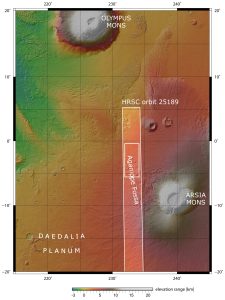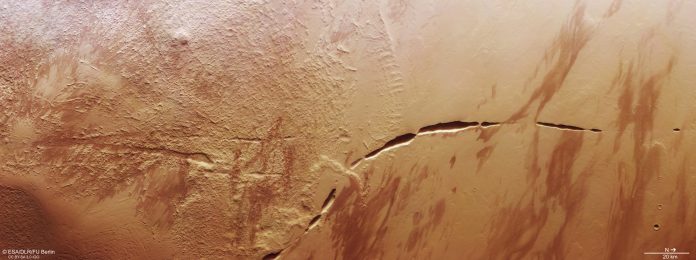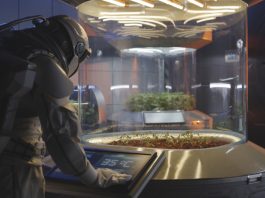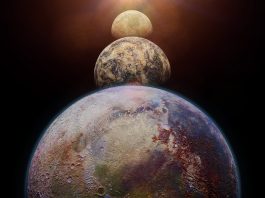A fascinating feature takes centre stage in a new image from ESA’s Mars Express – a dark, uneven scar on Mars, slicing through marbled ground at the foot of a giant volcano.
This scar, known as Aganippe Fossa, is a patchy, roughly 600km feature known as a ‘graben’ – a ditch-like groove with steep walls on either side.
Aganippe Fossa cuts across the lower flank of one of Mars’s largest volcanoes, Arsia Mons.
Mars Express regularly observes Arsia Mons and its nearby companions in the region of Tharsis, where several of Mars’s behemoth volcanoes are found.
How was Aganippe Fossa created?
The ESA is still unsure how and when Aganippe Fossa was created, but it seems likely that it was formed when magma rising underneath the mass of the Tharsis volcanoes stretched and cracked Mars’s crust.
In the new image, Mars Express’s High Resolution Stereo Camera (HRSC) captures two different kinds of terrain: so-called hummocky terrain, which comprises many irregularly shaped mounds and valleys clustered together, and lobate terrain, which is formed of gently sloping cliffs and rocky debris.

These terrains are characteristic of Arsia Mons’s ring-shaped ‘aureole’, a 100,000-square-kilometre disc around the volcano’s base, possibly associated with ancient glaciers.
This has only built up on the volcano’s northwestern flank, likely because prevailing winds from the opposite direction controlled where the ice settled over time.
Windblown dust and sand have also shaped this patch of Mars, creating interesting zebra-like patterns to the right of the frame as darker material is deposited on lighter ground.
The surface here also shows evidence of lava flows, dating from when the volcano was active.
Future exploration on Mars
Mars Express has been orbiting the Red Planet since 2003.
It is imaging Mars’s surface, mapping its minerals, identifying the composition and circulation of its tenuous atmosphere, probing beneath its crust, and exploring how various phenomena interact in the Martian environment.
The spacecraft’s HRSC, responsible for these images, has revealed much about Mars’s diverse surface in the past 20 years. Its images show everything from wind-sculpted ridges and grooves to sinkholes on the flanks of colossal volcanoes to impact craters, tectonic faults, river channels and ancient lava pools.
The mission has been immensely productive over its lifetime, creating a far fuller and more accurate understanding of our planetary neighbour than ever before.









